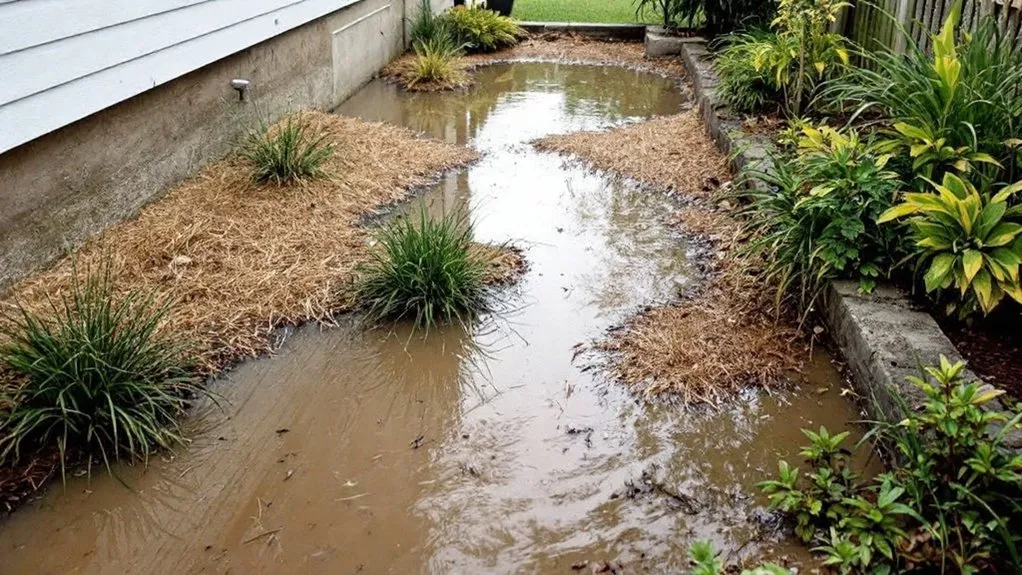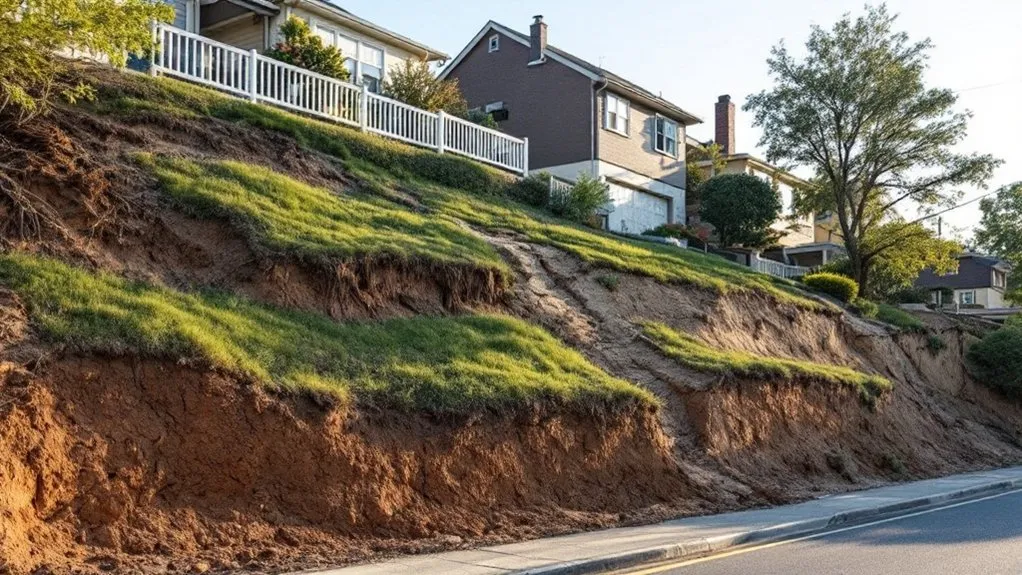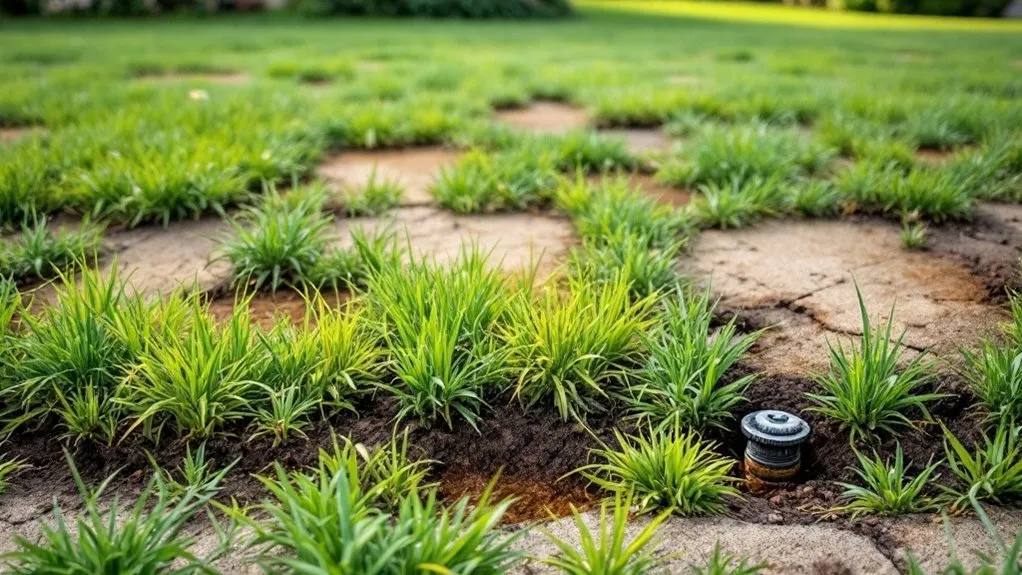The top 5 landscaping issues you’ll encounter include poor drainage leading to soil erosion, invasive weed growth competing with desired plants, landscape degradation from unstable soil, improper plant selection for your conditions, and ineffective lawn maintenance practices. You can prevent these through proper grading, regular weed control, installing drainage systems, choosing native plants, and following correct mowing techniques. Understanding these challenges and their solutions will transform your landscape management approach.
Key Takeaways
- Poor drainage can cause soil erosion and root rot – install French drains and grade landscape with a 2% slope away from structures.
- Invasive weeds harm desired plants – control through regular maintenance, mulching, and manual removal of entire root systems.
- Soil erosion washes away vital nutrients – prevented with proper drainage systems, ground cover plants, and slope retaining walls.
- Incorrect plant selection leads to maintenance issues – choose native plants and consider site conditions like sunlight and soil type.
- Improper lawn maintenance causes brown patches – follow seasonal mowing heights and never cut more than one-third of the grass length.
Poor Drainage and Water Management

Three significant problems arise from poor drainage in landscaping: soil erosion, root rot, and foundation damage.
You must implement effective drainage solutions to protect your property and plants. Install French drains or catch basins in low-lying areas where water pools, and grade your landscape with a 2% slope away from structures.
Consider incorporating rain gardens with water-loving plants to manage excess runoff while promoting water conservation.
Add permeable hardscaping materials like gravel or pavers to allow natural water absorption.
Regular gutters and downspouts maintenance guarantees proper water redirection away from your home’s foundation and landscape beds.
Invasive Weeds and Unwanted Plant Growth
While invasive weeds compete aggressively for nutrients and water, they can quickly overtake your landscape and compromise the health of desired plants.
To prevent this issue, implement a thorough weed control strategy that includes regular garden maintenance and early detection.
Apply a thick layer of mulch around plants to suppress weed growth, and remove any unwanted vegetation before it goes to seed.
You’ll need to manually pull weeds, ensuring you extract the entire root system.
Consider using pre-emergent herbicides in early spring to prevent weed seeds from germinating and maintain proper spacing between plants to minimize areas where invasive species can establish themselves.
Soil Erosion and Landscape Degradation

Poor soil stability can rapidly deteriorate your landscape’s integrity, leading to erosion that washes away valuable topsoil and nutrients.
To maintain soil quality and prevent degradation, you must implement sustainable practices that protect your terrain’s foundation.
- Install drainage systems and water management solutions to control runoff and prevent soil displacement.
- Add ground cover plants and mulch layers to protect exposed soil surfaces and enhance stability.
- Build retaining walls or terraces on slopes to minimize erosion and create level planting areas.
These solutions preserve your landscape’s structure and support long-term soil health and plant importance.
Improper Plant Selection and Placement
Selecting the wrong plants or positioning them incorrectly in your landscape can lead to extensive maintenance issues and plant failure.
You must assess your site’s conditions carefully before making plant choices. Consider factors like soil type, drainage patterns, and sun exposure throughout different seasons.
Choose native plants whenever possible, as they’re already adapted to your local climate and require less maintenance.
Don’t place sun-loving plants in shady areas or shade-preferring plants in full sun.
Account for mature plant size to prevent overcrowding and root competition.
Research each plant’s specific needs and growth habits to guarantee proper spacing and placement in your landscape.
Ineffective Lawn Maintenance and Care

Beyond proper plant selection, maintaining a healthy lawn demands consistent attention and appropriate care techniques.
You must master basic lawn fertilization techniques and follow seasonal mowing schedules to prevent common maintenance issues.
To maintain a vibrant, healthy lawn:
- Time your fertilization correctly – apply in early spring and fall when grass actively grows
- Adjust your mowing height seasonally – cut higher in summer to protect roots and retain moisture
- Follow the “one-third rule” – never remove more than 1/3 of the grass height in a single mowing
These practices help prevent brown patches, thin spots, and weed invasions while promoting robust turf growth.
Frequently Asked Questions
How Much Does Professional Landscaping Cost for an Average-Sized Backyard?
You’ll typically spend between $4,000 and $20,000 for professional landscaping in an average backyard (1/4 to 1/2 acre).
Your landscaping budget will vary based on several cost factors, including design complexity, material choices, and labor requirements.
Essential services like grading and sod installation start at around $4,000, while extensive designs with hardscaping, water features, and mature plants can push costs toward the higher end of the range.
Can I Landscape My Yard During Winter Months?
While you can do some winter landscaping, you must consider seasonal limitations.
When the ground is frozen, you can focus on planning, hardscaping projects, and structural elements. It’s also an ideal time to prune dormant trees and shrubs.
However, you’ll want to avoid planting most vegetation, as frozen soil and harsh conditions can prevent proper root establishment.
Save major planting projects for spring when conditions are more favorable.
What Permits Do I Need Before Starting a Major Landscaping Project?
Before starting your major landscaping project, check with your local municipality’s building department for specific landscaping regulations.
Standard permits include tree removal, drainage modifications, and hardscape installations.
You’ll also need project approvals to plan structural changes like retaining walls or water features.
Don’t forget to contact your homeowner’s association, if applicable, and utility companies to mark underground lines before breaking ground.
How Long Does a Typical Landscaping Project Take to Complete?
The duration of your landscaping project depends on its scope and complexity.
You’ll typically see small projects like garden beds completed in 2-3 days, while medium projects take 1-2 weeks. Large-scale transformations can extend to 4-6 weeks.
Project timelines are divided into distinct landscaping phases: design (1-2 weeks), site preparation (3-7 days), hardscaping (1-2 weeks), planting (2-4 days), and final touches (2-3 days).
Should I Hire a Landscape Architect or a Landscape Contractor?
Your choice depends on your project’s scope.
If you need extensive design services and detailed planning, hire a landscape architect – they’ll create master plans and handle complex design elements.
For straightforward installation and maintenance, a landscape contractor is your best bet.
If your project requires both design and execution, you might need both an architect for project management and design and a contractor for implementation.
